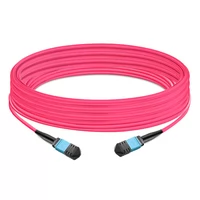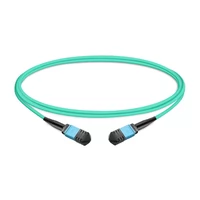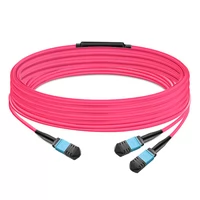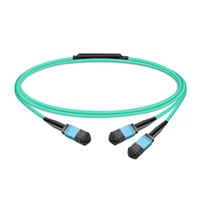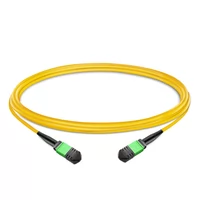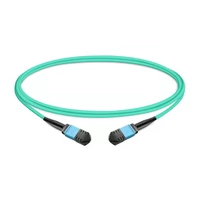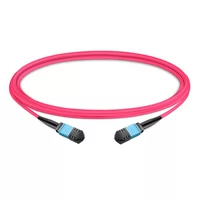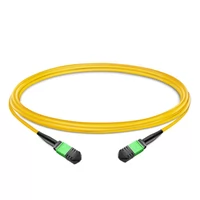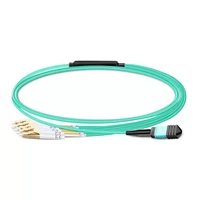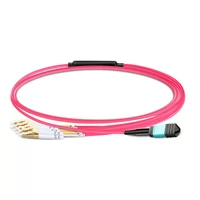The quick spread of data-heavy programs has resulted in a need for fast, adaptable, and productive communication networks. MPO (Multi-Fiber Push-On) connectors are the foundation of any modern fiber optic network; they ensure that enormous amounts of data can be transmitted seamlessly. In this paper, we will discuss what an MPO connector is as well as its design and function in high-density networking environments. This article also examines technical specifications and uses for these connectors so that readers can understand why they have become such an integral part in building up the current state-of-the-art infrastructure for fiber optics today.
Table of Contents
ToggleWhat is an MPO Connector and How Does It Work?

Definition and Components of an MPO Connector
The MPO (Multi-Fiber Push-On) connector is a kind of fiber optic connector that is designed to aggregate multiple optical fibers into one interface, saving space for fiber management and improving efficiency in high-density environments. An MPO connector consists of four main parts: the ferrule, housing, guide pins, and boot. The ferrule is usually made from ceramic or metal materials with high precision; it keeps many fibers firmly fixed in position. With mechanical protection being supplied by the housing, accurate alignment during mating with another MPO connector is ensured by guide pins while preventing cable integrity loss and excessive bending at the termination point, which is all done by boots. Thus, these things work together to enable fast data transmission rates over long distances, thereby making this device critical for setting up contemporary fiber networks characterized by large capacities and high-speed capabilities.
How an MPO Connector Integrates with Fiber Optic Systems
The MPO connector is a vital multi-fiber connection interface in fiber optic systems. This allows for fast and easy deployment of high-speed networks by supporting different configurations, including single-mode as well as multimode fibers, which can be patched to various devices such as cassettes or transceivers through patch panels, etcetera. To guarantee the best possible signal integrity, it has to align precisely with other network hardware like cassettes, patch panels, or transceivers while minimizing insertion loss and maximizing return loss. They are most commonly used in data centers and telecommunication infrastructures where both performance and space-saving matter most since they make it possible for cable density management to be done at higher levels, thus reducing installation times considerably.
Comparing MPO Connectors to Other Fiber Optic Connectors
In high-density settings, MPO connectors are more advantageous than LC, SC, and ST fiber optic connectors. Typically used for single-fiber applications, LC, SC, and ST connectors need multiple terminations which is what multi-fiber connections like MPO connectors are designed for. Therefore, this makes them very suitable for data centers with high-density installations. Additionally, the use of multiple fibers in their design enables faster installation times, hence reducing labor charges and setup times. Furthermore, these types offer better performance since they can handle high speeds while aligning fibers accurately, thus minimizing insertion loss, unlike traditional ones. However, achieving comparable performance levels may require more cables and involve higher maintenance efforts using conventional systems. Another thing about MPO connectors is that they have modularities which allow scalability in network expansion; this means that such devices can be upgraded easily to cater for future bandwidth needs.
How to Choose the Right MPO Connector for Your Needs?

Single Mode vs. Multimode MPO Connectors
It is important to know that each type has unique application needs and performance features when selecting between single mode and multimode MPO connectors. Single-mode MPO connectors are created for data transmission over long distances that are commonly used in telecommunication and fast network settings. They have about 9 microns core diameter, which enables them to support wider bandwidths, thus transmitting data over longer ranges without considerable signal losses.
In contrast to this, multimode MPO connectors possess quite large core diameters, usually 50 or 62.5 micrometers, making them appropriate for short-range connections within enterprise networks together with data centers. More so, multi-mode types are cheaper due to their associated transceivers as well as cables being more affordable than those used by single modes; moreover, multi-modes are also good for high-speed transfers of information within the same building or campus because they support up to 400 Gb/s rates.
To sum it up, choosing whether you will use a single mode or a multimode MPO connector depends on how much distance can be covered, what amount of money one has set aside for the project, and last but not least, bandwidth requirements. In detail, if there is a need for higher capacity at longer distances, then single mode will be suitable, while if the need is just within short ranges where high speeds are required, then multimodes should be adopted because they save costs, too.
Understanding Polarity in MPO Connectors
In MPO connectors, polarity refers to the way fibers are aligned and ensures that light is transmitted from a transmitter to a receiver along the correct path. There are three methods of polarity commonly used in MPO connectors namely Method A, Method B, and Method C.
- Method A (Straight-through): This method aligns corresponding fibers 1:1, i.e., fiber 1 (TX) on one end should match with fiber 1 (RX) on the other end; hence it requires Type A MPO cables and Type A adapters.
- Method B (Cross-over): It involves crossing over or flipping fibers so that fiber one at one end connects to fiber 12 at another end, fiber 2 connects with fiber 11 etc.; this uses Type B MPO cables & connections which make parallel optics implementation easier than any other method can do.
- Method C (Paired Flipped): In this technique, pairs are flipped where fiber number n at one side is connected to number n+1 on the opposite side, e.g. if we have duplexed applications such as bi-directional transmission channels like those found between two switches back-to-back connections where each switch has its own transmit/receive ports).
Knowing how polarity works and which method suits your network design best is important for maintenance purposes; getting it wrong may cause problems such as heavy signal loss making some parts of the system unreachable or even complete failure thus leading to connectivity issues within an optical communication network.
Factors to Consider: Low-Loss, 12 Fiber, and More
To select MPO connectors, there are many important points to consider that will help in achieving better performance and efficiency.
Connectors with Low Losses: They are designed to minimize insertion losses. These occur when some signal power is lost after inserting a device into the transmission line. It becomes very vital especially in high-density environments for networking at higher speeds where signal integrity should always be maintained. They usually achieve this by using better alignment and polishing methods, which leads to lower losses.
12 Fiber Connectors: The 12 fiber MPO connector is one of the most common configurations used regularly within data centers or any other place having high-speed networks. This type supports effective data transmission as well as simplifying cable management systems thus making work easier for network administrators. When installing these types of connectors ensure they adhere to such standards as TIA-568 or IEC 61754-7.
Other considerations: Other key aspects include connector robustness or strength, ease/simplicity during installation process plus compatibility with existing infrastructures among others. Additionally, it is crucial to also look into the scalability needs of your network because you never know what changes may occur; hence, future-proofing saves on expensive upgrades later, while instrument-grade connectivity, along with proper testing, can greatly improve reliability of overall networks.
Knowing these factors will enable one to make wise choices that guarantee the strong and efficient performance of a network system.
What Applications Benefit from MPO Connectivity?

Data Centers and High-Density Settings
MPO connectivity is highly advantageous to data centers and high-density environments because of its ability to provide support for fast data transmission and simplify cable management. As the need for bandwidth increases with the demand for quicker processing speeds, MPO connectors become more suitable in settings that require quick installation as well as minimum space occupation. They simplify network design by reducing congestion created by cables while also enhancing the airflow necessary for efficient cooling systems. Moreover, MPO connections allow scalability, thereby making them able to accommodate future growth in networks without extensive re-cabling or major alteration of infrastructure; all these factors combined make these types of links very important components in contemporary data centers among other densely populated networking locations as they satisfy both immediate performance requirements and potential expansion capabilities effectively.
Telecommunications and Network Backbones
Telecommunications and network core networks truly appreciate MPO connectivity, as it allows for the transfer of large volumes of data and improves overall efficiency. These connectors also have the ability to work smoothly with already existing structures, thereby optimizing those designed for older systems while getting ready for next-generation networks. Small size and modularity make these kinds of connectors very easy to install or even maintain, hence reducing downtimes, which in turn saves money used during operations. MPO technology is also known for its excellent scalability feature; this means that service providers can easily expand their connection points without necessarily undertaking a complete overhaul. With such a resilient solution like this one, reliability within networks becomes sustained since they are able to cater to current communication demands as well as anticipated technological advancements in the future.
Advancements in High-Speed Data Transmission
Optical fiber technology, Dense Wavelength Division Multiplexing (DWDM), and modulation formats have driven the development of high-speed data transmission. Latency has been reduced, and data can travel faster over longer distances due to optical fibers, which provide greater bandwidth. This allows multiple data signals to be carried simultaneously on different wavelengths of light, increasing the capacity and efficiency of existing fiber optic cables thanks to DWDM technology. Quadrature Amplitude Modulation (QAM) is another type of advanced modulation format that increases data transmission rates by encoding more bits per signal. In summary, these technologies form the foundation of modern telecommunications so that networks are able to cope with increasingly fast demands for information transfer.
What Are the Standards and Certifications for MPO Connectivity?

Key Certifications and Compliance Standards
For maximum performance and interoperability in the field of MPO connectivity, there are several certifications and compliance standards. The TIA-568 standards of the Telecommunications Industry Association are among the most important ones. These provide a basis for structured cabling systems with different manufacturers’ components like MPO connectors being required to meet certain specifications thereby ensuring uniform performance.
Another standard essential in this area is IEC 61754-7 by International Electrotechnical Commission which gives dimensions and other operational requirements for MPO connectors thus making sure that they are designed according to specific criteria essential for worldwide compatibility as well as reliability.
In addition, ISO/IEC 11801 addresses generic cabling for customer premises so as to support high-speed data transmission through wide area networks using fiber optic cables terminated with multi-fiber push-on connectors such as those conforming with IEC 61754-7 standard mentioned earlier. All these standards together strive to safeguard against compromise, scalability, integrity, efficiency, etcetera of telecommunications infrastructure vis-a-vis technological advancements within universally accepted norms or ethics based on best practices recognized throughout industrywide standards bodies like TIA EIA, IEEE, etcetera.
Importance of Certification in Network Reliability
To establish an ideal network, certification is important because it ensures that all the parts in a complicated telecommunication system can work together. For instance, TIA-568, IEC 61754-7, and ISO/IEC 11801 are some of the common certifications whose guidelines must be followed by manufacturers and service providers to avoid compatibility problems or inefficiencies during operation.
To keep the quality of items uniform across the board, certificates make sure that parts such as multi-fiber push-on (MPO) connectors conform to strict industry norms. Ideal network performance is dependent on this regularity because it averts signal loss, minimizes downtimes, and improves general data transmission integrity. Furthermore, sticking to these benchmarks aids in scalability, thereby enabling systems to easily adjust to changing technology needs while still maintaining high-speed limits, which are essential for large file transfers, among others, thus not compromising on availability. Consequently, without them, telecommunication infrastructures cannot be strong enough to handle heavy traffic loads and work reliably.
Common Issues and How to Troubleshoot MPO Connector Problems
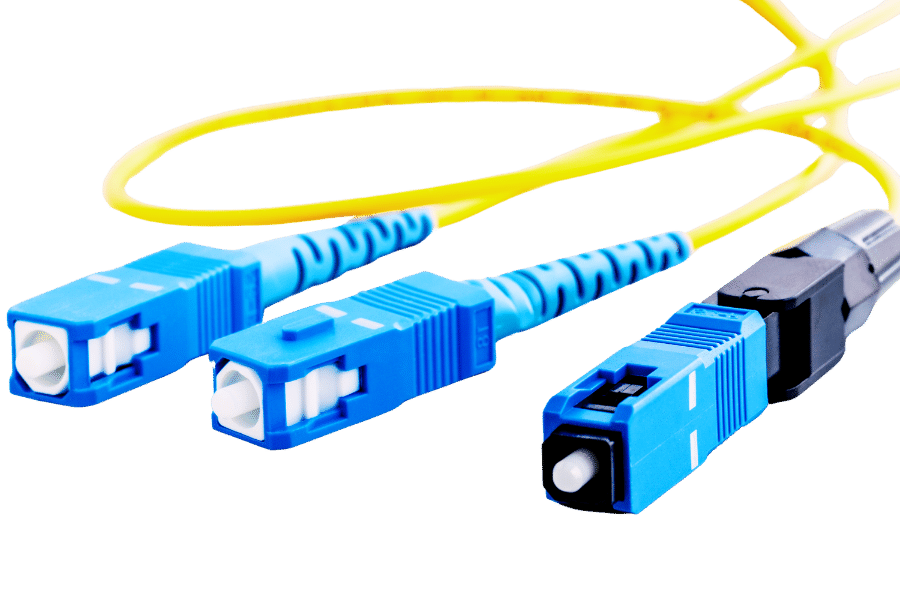
Frequent MPO Connector Issues and Solutions
With MPO connectors, quite a few issues can emerge which affect the reliability and performance of networks. Here are some common problems along with their possible solutions:
- Contamination and Dirt: Dust or dirt usually contaminates MPO connectors thus affecting signal transmission. Solution: Regularly clean and inspect MPO connectors using correct cleaning tools like lint-free wipes or optical connector cleaners.
- Connector Misalignment: When an MPO connector is misaligned, it can cause signal loss and increase return loss. Solution: Ensure that during installation the connectors are seated well to achieve accurate alignment as confirmed by alignment tools/testers calibrated for use with these types of connectors.
- Fiber End-face Damage: Fiber end-faces are delicate so they can easily get scratched or damaged leading to poor performance. Solution: When handling them during installation or maintenance always cover with protective caps; if any damage is found, re-terminate or replace affected connectors.
By taking care to address these challenges through proper handling procedures as well as regular maintenance works, one can greatly enhance the performance plus reliability levels exhibited by MPO connectors in telecom networks.
Maintenance and Care for Prolonged MPO Cable Lifespan
Taking care of and expanding the lifespan of MPO cables requires constant attention as well as adherence to good practices. Here are some necessary steps for maintenance that are based on what is recommended by the industry:
- Frequent inspections: Often examine your MPO connectors and cables for signs such as wear, damage or dirt. You should have a good quality inspection microscope so that you can check the condition of your fiber end-faces.
- Cleaning correctly: Clean MPO connectors before every mating cycle with specific tools meant for cleaning MPOs. To prevent residue, it is advised that one uses dry cleaning techniques like lint-free swabs or cassette cleaners, but wet cleaning using isopropyl alcohol may be done if need be.
- Handling properly: Ensure gentle handling of MPO cables to avoid bending, twisting, or pulling, which destroys internal fibers. Always keep proper bend radius management tools and strain relief components handy for cable bend radius maintenance.
- Control the environment: For dust, moisture and extreme temperatures prevention purposes, store these cables in clean dry places. When not in use protect connectors using caps so that they do not get contaminated.
- Regular testing: Use optical time-domain reflectometers (OTDR) or loss testers for frequent performance tests aimed at identifying any signal quality degradation. Any abnormality detected must be addressed immediately after being recorded.
If network experts follow these guidelines during their work then they will maximize reliability as well as efficiency throughout entire networks while also achieving highest possible performance levels from their multi-fiber push-on (MPO) connections.
Reference sources
- Fiber Optic Association – MPO Connectors in Fiber Optic Networks
- Source: Fiber Optic Association
- Summary: The Fiber Optic Association explains what MPO connectors are and how they work. They are considered to be the backbone of fiber optic networks because they allow for faster data transmission rates than other types of connectors. This source also provides information about their technical specifications, applications in network infrastructure, benefits for high-speed data transmission and more which makes it a valuable resource for professionals who need or want to know more about MPO technology.
- Optical Connections Magazine – Exploring the Role of MPO Connectors
- Source: Optical Connections Magazine
- Summary: According to Optical Connections Magazine, “MPO connectors have become ubiquitous with fiber optic networks worldwide.” The article goes on to discuss many different aspects of this type of connector, including its evolution over time, best practices for deploying them within networks, and their impact on overall performance levels once implemented correctly. This is another great resource if you’re looking for something practical based on network connectivity optimization using MPO solutions.
- Corning – MPO Technology Guide for Fiber Optic Networks
- Source: Corning – MPO Technology Guide
- Summary: Corning provides an extensive guide on MPO technology for fiber optic networks. This source looks at different design principles of MPO connectors, their compatibility with various network architectures, and tips for ensuring reliable connections. Network engineers and technicians can find useful tips from this source when working with MPO technology effectively.
Frequently Asked Questions (FAQs)
Q: What is an MPO connector?
A: An MPO connector, also known as a Multi-Fiber Push-On connector, is a type of fiber optic connector that can house multiple fibers in a single ferrule. This enables high-density connections and is commonly used in data centers and other applications where large numbers of optical fibers need to be connected.
Q: How do MPO fiber connectors work?
A: MPO fiber connectors work by precisely aligning multiple fibers within a single ferrule. This alignment ensures efficient transmission of data between each individual fiber optic cable inside the connector, so that communication remains fast and reliable.
Q: What are the benefits of using MPO connectors?
A: There are several advantages associated with using MPO connectors including reduced installation time due to their ability to connect multiple fibers simultaneously. They also provide scalability as networks can easily grow or shrink depending on demand since they support more than one strand of optic fiber. This makes them ideal for environments with complex connectivity needs, such as those found within data centers where space may be limited but bandwidth requirements high.
Q: What are some common applications of MPO connectors?
A: Data centers, enterprise networks, and telecommunications systems often use multi-fiber push-on connectors for high-speed links that require a lot of space. They can be found in trunk cables, patch cords, or other fiber optic connections where there is a need to connect multiple fibers together at once, such as those used in data centers.
Q: How does the MPO certification process work?
A: The MPO certification process verifies whether or not a particular connector meets certain performance criteria necessary for high-speed data transmission. Common tests include insertion loss testing, return loss measurement, and fiber position evaluation, among many others.
Q: What are the typical configurations for MPO trunk cables?
A: MPO trunk cables usually have 12 or 24 fibers and they are often used to connect high density patch panels. For example, a 24-fiber trunk cable can accommodate up to four different sizes of fiber diameters which range from 4.5mm – 4.9mm therefore making it easier for technicians when organizing their cabling solutions within limited spaces like cabinets etcetera.
Q: What should be considered when selecting an MPO fiber connector?
A: When selecting an MPO fiber connector you need to look at factors such as; number of fibers available (12-144), type of optic cable required (single mode / multimode), male/female gender specification plus additional features like pull tab design etcetera which may affect its compatibility with your specific application needs.
Q: What is meant by ‘Guide Pins’ in MPO connectors?
A: Guide pins refer to alignment pins used with multi-fiber push-on connectors so that all fibers within the ferrule align precisely opposite corresponding ones on the mating side, thereby ensuring optimal performance/reliability throughout the entire link length between two devices connected via these types of optical connections.
Q: How does MPO connector density impact data centers?
A: The more densely packed together multi-fiber push-on connectors are, the higher number connections can be made within limited space available in data centers. This is very important for large data centers that handle massive amounts of information because it allows them to expand their capacity without needing too many physical connections.
Related Products:
-
 NVIDIA MFP7E10-N035 Compatible 35m (115ft) 8 Fibers Low Insertion Loss Female to Female MPO Trunk Cable Polarity B APC to APC LSZH Multimode OM4 50/125
$118.00
NVIDIA MFP7E10-N035 Compatible 35m (115ft) 8 Fibers Low Insertion Loss Female to Female MPO Trunk Cable Polarity B APC to APC LSZH Multimode OM4 50/125
$118.00
-
 NVIDIA MFP7E10-N003 Compatible 3m (10ft) 8 Fibers Low Insertion Loss Female to Female MPO Trunk Cable Polarity B APC to APC LSZH Multimode OM3 50/125
$35.00
NVIDIA MFP7E10-N003 Compatible 3m (10ft) 8 Fibers Low Insertion Loss Female to Female MPO Trunk Cable Polarity B APC to APC LSZH Multimode OM3 50/125
$35.00
-
 NVIDIA MFP7E20-N050 Compatible 50m (164ft) 8 Fibers Low Insertion Loss Female to Female MPO12 to 2xMPO12 Polarity B APC to APC LSZH Multimode OM4 50/125
$145.00
NVIDIA MFP7E20-N050 Compatible 50m (164ft) 8 Fibers Low Insertion Loss Female to Female MPO12 to 2xMPO12 Polarity B APC to APC LSZH Multimode OM4 50/125
$145.00
-
 NVIDIA MFP7E20-N003 Compatible 3m (10ft) 8 Fibers Low Insertion Loss Female to Female MPO12 to 2xMPO12 Polarity B APC to APC LSZH Multimode OM3 50/125
$52.00
NVIDIA MFP7E20-N003 Compatible 3m (10ft) 8 Fibers Low Insertion Loss Female to Female MPO12 to 2xMPO12 Polarity B APC to APC LSZH Multimode OM3 50/125
$52.00
-
 NVIDIA MFP7E30-N003 Compatible 3m (10ft) 8 Fibers Low Insertion Loss Female to Female MPO Trunk Cable Polarity B APC to APC LSZH Single-Mode OS2 9/125
$42.00
NVIDIA MFP7E30-N003 Compatible 3m (10ft) 8 Fibers Low Insertion Loss Female to Female MPO Trunk Cable Polarity B APC to APC LSZH Single-Mode OS2 9/125
$42.00
-
 1m (3ft) 12 Fibers Female to Female MPO Trunk Cable Polarity B LSZH OM3 50/125 Multimode Fiber
$20.00
1m (3ft) 12 Fibers Female to Female MPO Trunk Cable Polarity B LSZH OM3 50/125 Multimode Fiber
$20.00
-
 1m (3ft) 12 Fibers Female to Female MPO Trunk Cable Polarity B LSZH Multimode OM4 50/125
$21.00
1m (3ft) 12 Fibers Female to Female MPO Trunk Cable Polarity B LSZH Multimode OM4 50/125
$21.00
-
 1m (3ft) 12 Fibers Female to Female MPO Trunk Cable Polarity B LSZH OS2 9/125 Single Mode
$26.00
1m (3ft) 12 Fibers Female to Female MPO Trunk Cable Polarity B LSZH OS2 9/125 Single Mode
$26.00
-
 1m (3ft) MPO UPC Female to 4 LC UPC Duplex OM3 50/125 Multimode Fiber Breakout Cable, 8 Fibers, Type B, LSZH, Aqua
$20.00
1m (3ft) MPO UPC Female to 4 LC UPC Duplex OM3 50/125 Multimode Fiber Breakout Cable, 8 Fibers, Type B, LSZH, Aqua
$20.00
-
 1m (3ft) MPO UPC Female to 4 LC UPC Duplex OM4 50/125 Multimode Fiber Breakout Cable, 8 Fibers Type B, LSZH, Aqua/Violet
$23.00
1m (3ft) MPO UPC Female to 4 LC UPC Duplex OM4 50/125 Multimode Fiber Breakout Cable, 8 Fibers Type B, LSZH, Aqua/Violet
$23.00

